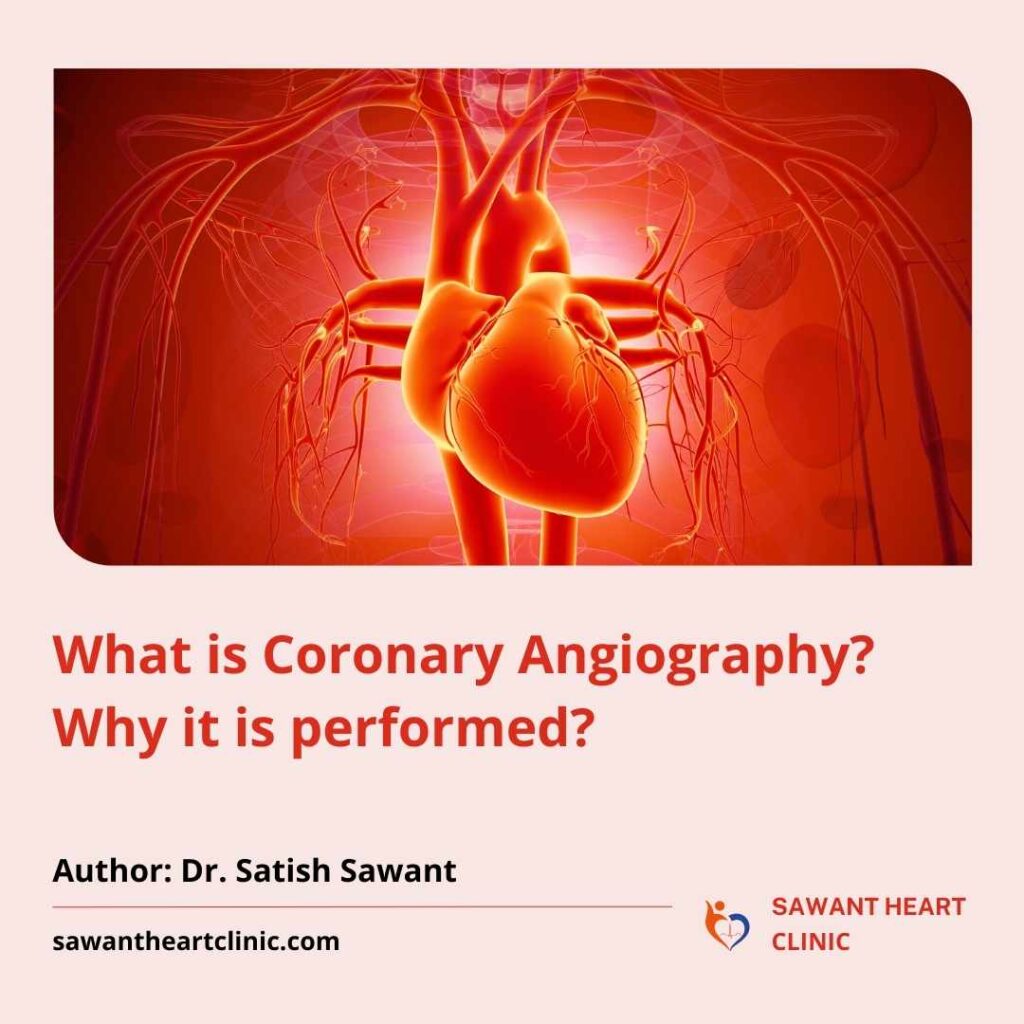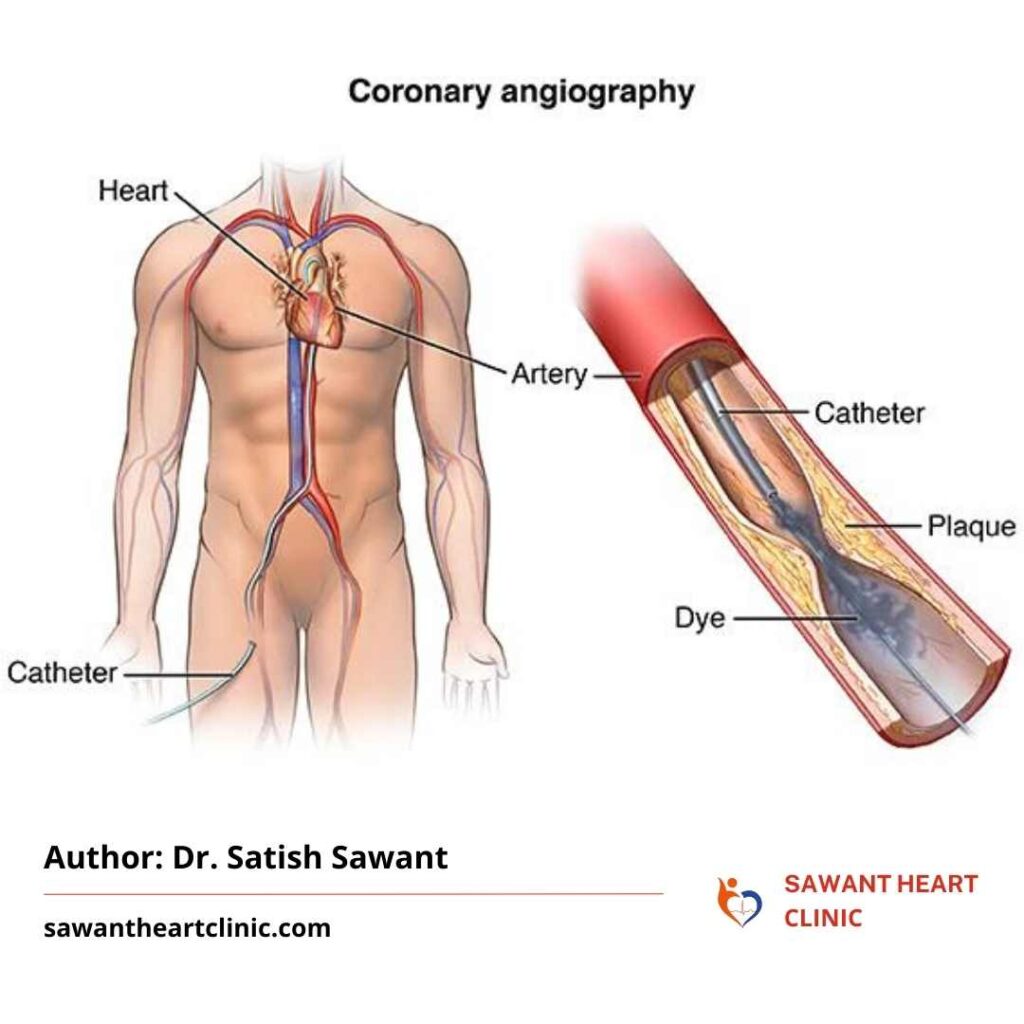Coronary Angiography is a test that examines the coronary arteries of the patient's heart.
Angiography is a medical imaging procedure used to examine the patient’s organs and blood arteries. This is done primarily to diagnose blockages and other issues in the veins, arteries, and heart chambers. It is accomplished with the use of an X-Ray-based technology, such as fluoroscopy. (Immediately obtains moving pictures using X-Ray).
A contrast agent, such as a particular dye, is delivered into the bloodstream through a catheter (a tiny plastic tube), highlighting the blood arteries. As the blood vessels move, they appear white on the angiography. Then X-Rays are collected and analyzed.

Why is Coronary Angiography performed?
Coronary angiography is performed for various reasons, like:
- Angina – Chest pain or any kind of discomfort.
- Unstable Angina – When chest pain becomes worse and occurs more often.
- Unexplained pain in the chest, arm, jaw, or neck.
- Coronary thrombosis or Blood clots
- Congenital heart disease – Defect in heart present from birth.
- Chest injury or other problems with blood vessels.
- Unusual chest pain even when all the tests are normal.
- Problem with heart valve that requires surgery.
- Heart failure
- Atypical results of heart stress test
- After a recent heart attack.
- If you are going to have a surgery in which you have a high chance of getting a heart attack or other problems related to heart.
What are the types of angiographies and how long does it required to perform angiography?
Coronary angiography is of 2 types:
Catheter coronary angiography – In this procedure, a catheter is guided into your artery in your arm or groin. The catheter is moved towards the opening of your coronary arteries, and then injected with a contrast agent. Then, X-Rays of the blood vessels are taken.
Non-invasive coronary angiography – In this procedure a catheter is not used, instead imaging tests like an ultrasound or MRI (Magnetic Resonance Imaging), or CT (Computed Tomography) are done to take an X-Ray of the blood vessels.

It usually takes up-to 30 minutes to perform coronary angiography. Interventional cardiologists like Dr. Satish Sawant performs coronary angiography in cathlab which are well equipped with all the necessary instruments for angiography and angioplasty.
What are the side effects of coronary angiography?
Coronary angiography is a common procedure that rarely causes serious problems. Possible complications may include bleeding, allergic reactions to the contrast dye, infection, blood vessel damage, arrhythmias, blood clots that can trigger a heart attack or stroke, kidney damage, and fluid buildup around the heart.
What is the cost of coronary angiography in Pune?
Cost of coronary angiography varies from hospital to hospital. It is usually between the range of 20 thousand Indian Rupees to 50 thousand Indian Rupees.
Where can you get angiography in Pune?
Dr. Satish Sawant of Sawant Heart Clinic has more than 15 years of experience, He is one of the best interventional cardiologist in Pune to perform angiography and complicated angioplasty procedures. You can consult him at his clinic on pune-satara road, swargate, Pune.
Saving Hearts, Changing Lives!
Get in Touch
Contact Details
Address
Sawant Heart Clinic, office no 212,213, second floor, Lotus court, above kaka halwai, near panchami hotel, Pune - Satara road, Swargate, Pune 411009.
Phone Numbers
+91- 9011233322
sawantheartclinic@gmail.com
Fill up this form to book appointment
Book Appointment
Saving Hearts, Changing Lives!
FAQ
An ECG can help detect:
arrhythmias – where the heart beats too slowly, too quickly, or irregularly
coronary heart disease – where the heart’s blood supply is blocked or interrupted by a build-up of fatty substances
heart attacks – where the supply of blood to the heart is suddenly blocked
cardiomyopathy – where the heart walls become thickened or enlarged
The precise difference between ECG and ECHO is that ECG showcases the heart’s electrical system, whereas ECHO showcases the heart’s mechanical system for further investigation and planning of the respective patient’s treatment.
Angiography or arteriography is a medical imaging technique used to visualize the inside, or lumen, of blood vessels and organs of the body, with particular interest in the arteries, veins, and the heart chambers.
Angioplasty is a procedure to open narrowed or blocked blood vessels that supply blood to the heart. These blood vessels are called the coronary arteries. A coronary artery stent is a small, metal mesh tube that expands inside a coronary artery. A stent is often placed during or immediately after angioplasty.
The most common reason people get a pacemaker is their heart beats too slowly (called bradycardia), or it pauses, causing fainting spells or other symptoms. In some cases, the pacemaker may also be used to prevent or treat a heartbeat that is too fast (tachycardia) or irregular.
Sawant Heart Clinic by Dr. Satish Sawant is the most advanced cardiac care clinic in Pune, located on Pune-Satara Road, Near Panchami Hotel, Above Kaka Halwai, Swargate.
At Sawant Heart Clinic, we provide Preventive Heart Health Checkup services which helps you to detect any heart disease at early stage. Dr. Satish Sawant, one of the best cardiologist in pune recommends yearly health checkup for all adults above age 40 years.
